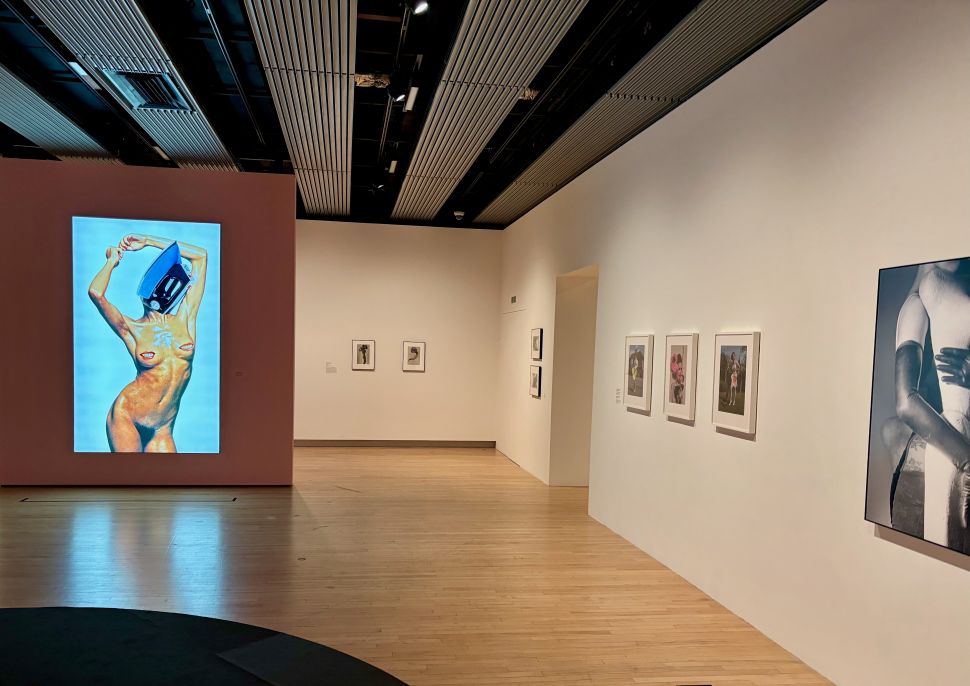When U.K. punk band the Buzzcocks were looking for cover art for their 1977 Orgasm Addict single, twenty-three-year-old Linda Mulvey had just completed a graphic design degree at Manchester Polytechnic. The band settled on one of Mulvey’s untitled photomontages for their cover—a naked female torso with a steam iron instead of a head. A year later, Linder changed her first name, jettisoned her family name and formed her own band. Ludus was a fiercely experimental musical collective that gave Linder a platform to express her anger at the commodification of women’s bodies and admiration for the performative vocal experiments of Yoko Ono and Meredith Monk. Taking its name from the 1982 Ludus album, “Danger Came Smiling” at London’s Hayward Gallery is Linder’s biggest exhibition to date, a retrospective that covers everything from the artist’s time as a member of Manchester’s post-punk sovereignty through to her current position as Brit art national treasure.
There are two versions of the Orgasm Addict artwork on show here—the original color montage and an imposing, ceiling-height print (freshly titled It’s The Buzz, Cock! in 2015). The piece sets the exhibition’s tone. The majority of Linder’s work revolves around her collaging like a Dada mistress, and the gallery’s walls are lined with dozens of re-arranged black and white self-portraits and photomontages made using clippings from porn and women’s interest magazines. Linder’s early-career success came from her ability to poke fun at the male gaze, starting with the paradoxical hypocrisy of prevailing pearl-clutching taboos around sex and the blatant daily objectification and exploitation of women. And, like Barbara Kruger in the U.S., Linder’s take on feminism was constructed using photocopiers, scalpels and glue. Thus, male appendages in her images are covered by cut-out pot plants and domestic appliances, while pink and purple lilies preserve the modesty of languid female porn stars. It’s pretty funny, like when Marcel Duchamp drew a mustache on the Mona Lisa, only with added nudity and food mixers. Linder’s Buzzcocks intro and early-1980s Ludus gigs led to other music-related projects. The glass cases on show contain portrait photos of Howard Devoto (Buzzcocks founder member and mainstay of avant-rockers, Magazine), designs for Magazine record covers, a flier for a 1978 Joy Division gig and drawings of punk muse and Vivienne Westwood store assistant Jordan, a.k.a., Pamela Rouke.
SEE ALSO: In Her Hong Kong Debut, Dominique Fung Reckons With Ancestral History
The 1990s were a quiet time for Linder, and the exhibition neatly skips forward to the mid-2000s as porn and fetishism continued to work as a conduit for her deep dives into social psyches. In 2011 she created a series of photographs after finding Splosh!, a magazine dedicated to sploshing, the fetish of covering the naked self in food. In Action Rituelle des Ancêtres, the artist and an unnamed other drip gloopily in rainbows of sauce, gravy and custard.
2013 saw a kind of Linder revival as various museums and galleries twigged to her importance—even though the clues had been there all the time. After all, this was the performer who made a raw meat dress to wear when she sang with Ludus decades before Lady Gaga wore her own meat dress to the 2010 MTV Video Music Awards. There were 2013 Linder exhibitions featuring new and revisited work at the U.K.’s Hepworth Gallery and Tate St Ives, and The Musée d’Art Moderne de la Ville de Paris staged “Femme/Objet,” the first full-scale Linder retrospective the same year. As public interest grew, the artist’s reflections on her performance background percolated to the surface. In 2013 she created The Ultimate Form, her first ballet in collaboration with choreographer Kenneth Tindall, and costumes designed for the dance are on display. Diagrams of Love: Marriage of Eyes is also here, a magnificent serpentine embroidery used in another Linder/Tindall ballet collaboration, Children of the Mantic Stain, this time from 2016.
Placed on top of a glass case next to the ballet costumes and assembled by Linder in 2023, L’effet de la curiosité féminine (The Effect of Feminine Curiosity) is an Angela Carter-like examination of women’s representation. Its bell-jarred contents of gilt leaves and vanity mirror is a globe de mariée, a decorative gift given to wealthy brides in nineteenth-century France. The base of the globe is slammed down tightly to trap a length of hair sourced from China and bleached blonde to conform to Western standards. Other newer works include The Most Sacred Monster of Photomontage in Her Time, a 2025 work that finds Linder riffing on Salvador Dalí’s Shirley Temple: The Youngest, Most Sacred Monster of the Cinema in Her Time from 1939. In the source material, Dalí added the head of child star Shirley Temple to a sphinx. In a time when deepfakes—particularly those using pornographic images—are a grave concern for women, Linder’s reworking of herself as the sphinx’s head is apt. The work also shows how prescient Linder’s early experiments were as an artist provocateur born of a time when disruption was an art in itself. And, like Dalí, Linder the human being is as much a piece of art as the work she’s made. In mirroring punk culture’s anarchic dialectics, Linder was the precursor of the influencer—albeit a raucous, heterodoxic one. She’s a figure who puts herself at the center of the conversation, garlanding the world she creates with her art along the way.
“Linder: Danger Came Smiling” is at the Hayward Gallery in London through May 5, 2025. Advance booking is recommended.

